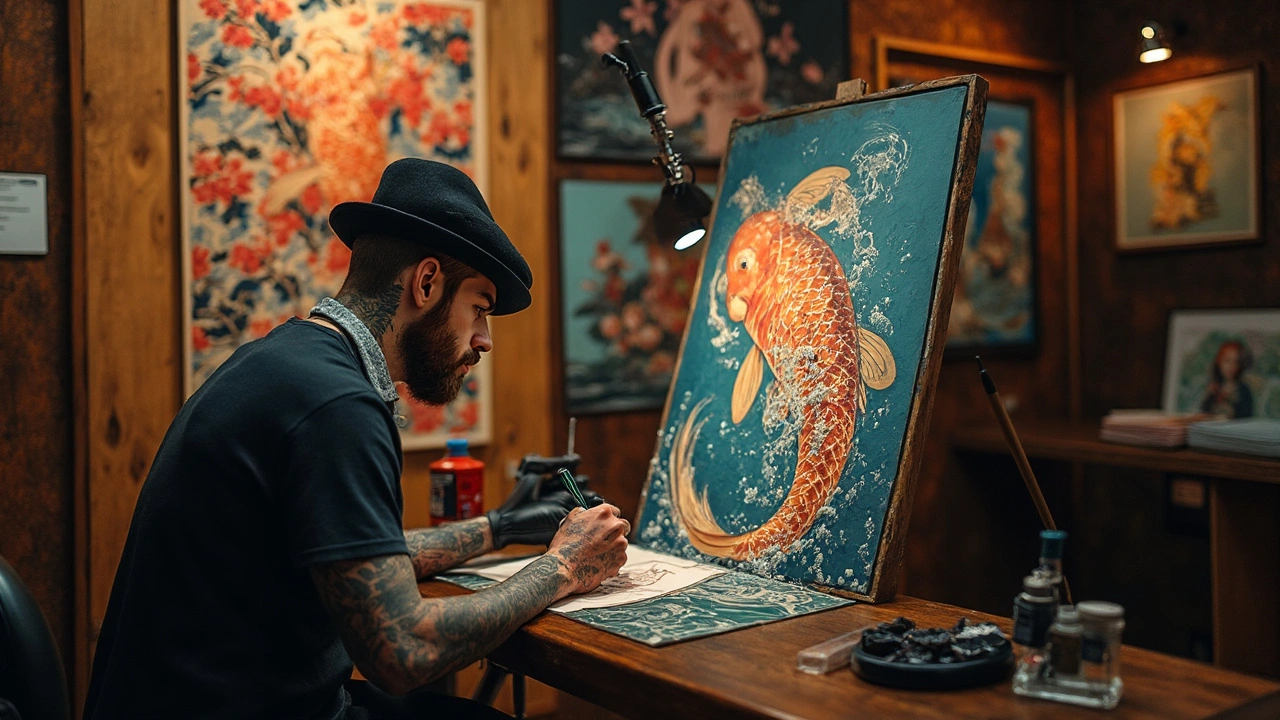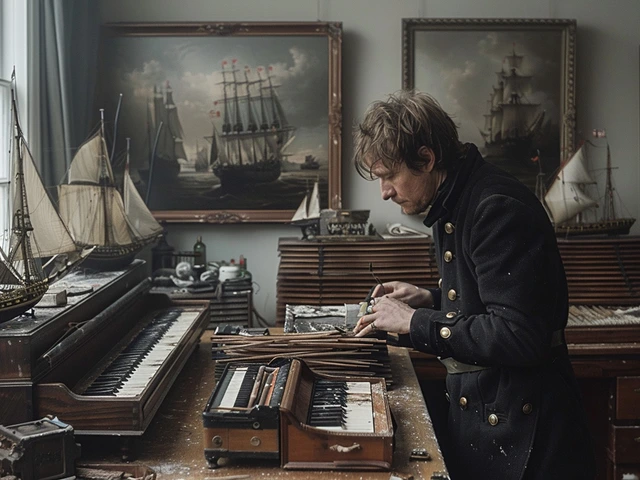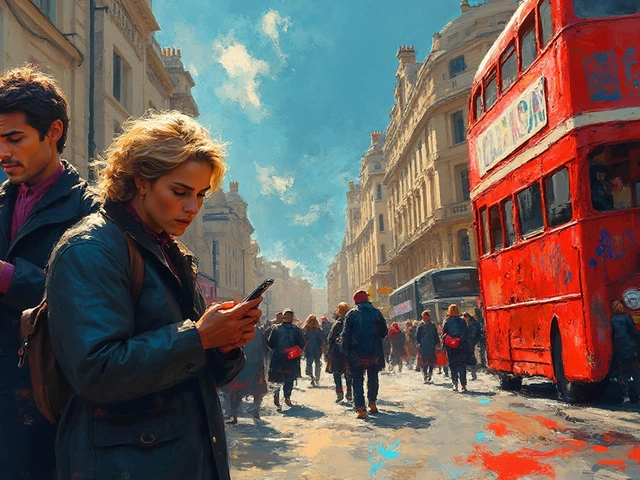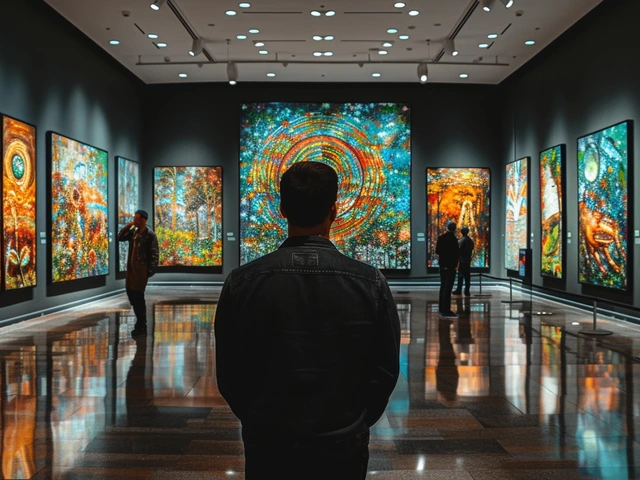Most people know Japanese tattoos for their bold lines, dramatic scenes, and stories packed into every inch of skin. But here's the twist: a lot of that style comes from ukiyo-e—those old-school woodblock prints you see in museums and hip cafes.
Ever wondered why you see tattoos of samurai, koi fish, or peonies everywhere? It's not just because they look cool. These images started out in ukiyo-e prints, and tattoo artists borrowed them because they were designed to be both eye-catching and loaded with meaning. Ukiyo-e prints were meant to grab your attention in busy streets. Turns out, that works pretty well for tattoos too.
If you're thinking about getting a classic Japanese tattoo, or you just want to spot the connections, it's worth knowing what makes ukiyo-e special. Get ready to see those swirling waves, legendary heroes, and rebellious geishas in a whole new way—etched under the skin instead of on paper. It's not just art: it's tradition with a sharp, modern edge.
- What Is Ukiyo-e, Really?
- Why Ukiyo-e Became Linked to Tattoos
- Famous Ukiyo-e Artists Who Shaped Tattoo Styles
- Motifs That Travelled from Prints to Skin
- How Tattoo Artists Adapt Ukiyo-e Today
- Tips for Spotting Ukiyo-e in Modern Tattoo Art
What Is Ukiyo-e, Really?
So, what’s the deal with ukiyo-e? In the simplest way, it’s a type of Japanese art made with woodblock printing. People started making these prints back in the 1600s, mainly during the Edo period. This was Japan’s big city and pop culture boom—think kabuki actors, sumo wrestlers, street scenes, and crazy festival crowds. Ukiyo-e literally means “pictures of the floating world,” because it was all about everyday life, style, and what felt cool at the time.
These prints weren’t just for rich folks. They were everywhere—from book covers to advertisements, fans, calendars, and even wrapping paper. You could buy one for the price of a bowl of noodles. Regular people got to see bold art that was colorful, fast to make, and easy to collect. That’s a huge reason why the ukiyo-e look stuck around—lots of people saw it, and they remembered it.
| Period | Major Artists | Popular Subjects |
|---|---|---|
| 1600s–1800s | Hokusai, Hiroshige | Landscapes, samurai, geishas, kabuki actors |
| Late 1800s | Kuniyoshi, Yoshitoshi | Mythical creatures, criminals, epic battles |
Key thing: ukiyo-e wasn’t about fancy portraits or fluffy stuff. It’s action scenes, strong lines, and serious drama—basically early comic art. This mix of clear stories, big characters, and epic style is exactly why tattoo artists were drawn to it. They needed designs that could tell a story and hold up over time. Ukiyo-e fit the bill perfectly.
Next time you spot a Japanese print with wild waves, giant carp, or fierce warriors, you’re looking straight at a snapshot of the original pop culture—and the source of that famous Japanese tattoo flair.
Why Ukiyo-e Became Linked to Tattoos
Way back in the Edo period (1603-1868), ukiyo-e prints were basically the pop culture posters of Japan. They showed actors, sumo wrestlers, epic warriors, and all sorts of wild stories. Regular folks could afford them, so these prints were everywhere—just like tattoo flash sheets are today.
The cool thing is, a lot of people started wanting those same images on their bodies. Criminals and outcasts picked up tattooing as a way to push back against the system, using bold ukiyo-e artwork to make a statement. As tattoo artists got better, ordinary people wanted in too. Samurai, merchants, and firefighters wore full-body tattoos to show toughness, but also to put those ukiyo-e scenes into real-life action.
One thing that made ukiyo-e perfect for tattoos was the way the designs worked on flat paper and curved bodies. Big, simple lines and strong contrast were easy for tattooers to copy—even in the days before electric machines. Characters from popular stories, dramatic facial expressions, and detailed wildlife became classics. It was art they could literally carry with them, for everyone to see.
- Ukiyo-e prints were cheap and everywhere, so their images stuck in people’s heads.
- Tattoo artists used ukiyo-e outlines to design full back or body suits, fitting scenes to muscle and bone.
- Woodblock prints’ bold lines and solid colors made it easier for tattoos to hold up over time.
| Motif | Why It Worked for Tattoos |
|---|---|
| Dragons | Big, twisty shapes fit the body; meant wisdom and strength |
| Koi Fish | Symbolized bravery; flowed along arms or backs |
| Heroes/Samurai | Showed courage, often pulled right from ukiyo-e prints |
| Floral Designs (cherry blossoms, peonies) | Brought color and movement; had cultural meaning |
So when you notice a Japanese tattoo packed with bold colors and detailed scenes, that's the ukiyo-e legacy right there. This art form wasn't just about making walls pretty—it literally shaped how people decorated their own bodies, and those roots still run deep in tattoo culture now.
Famous Ukiyo-e Artists Who Shaped Tattoo Styles
If you trace classic Japanese tattoo art back to its roots, you keep running into the same famous names. These ukiyo-e artists didn’t just paint pretty pictures—they created the blueprint for what’s inked on skin today. Their works shaped more than posters and prints; they defined the imagery for the whole world of Japanese tattoos.
First up, Hokusai. You can’t talk about ukiyo-e without mentioning the guy behind “The Great Wave off Kanagawa.” Those powerful waves, bold lines, and dramatic sense of movement made his style perfect for tattoo art. Even now, if you spot a tattoo with swirling water or Mt. Fuji, there’s probably a piece of Hokusai DNA in it.
Then there’s Utagawa Kuniyoshi. This guy was all about samurai, mythical monsters, and epic scenes from old Japanese stories. His prints featured wild action, lots of detail, and fierce warriors with full-body tattoos. Modern tattoo artists borrow directly from his work, not just for the characters but for the layout and flow of the designs.
And don’t forget about Hiroshige. While he’s known for landscapes, his way of framing scenes—like cherry blossoms or sudden rain—showed tattoo artists how to fit big stories into the shape of arms, backs, or legs. His approach to color and negative space is something many tattooers still aim for.
Here’s the thing: these ukiyo-e legends did more than influence artwork. Their pieces basically gave people a ‘menu’ of motifs and techniques that tattoo artists still pick from. If you flip through a book of old prints, you’ll see cranes, tigers, demons, and even background patterns that look just like what’s trending in tattoo shops today.
If you ever wondered why Japanese tattoo art looks so instantly recognizable, thank Hokusai, Kuniyoshi, and Hiroshige. Their prints are like a library for tattoo artists, filled with tried-and-true designs that have stood the test of time.
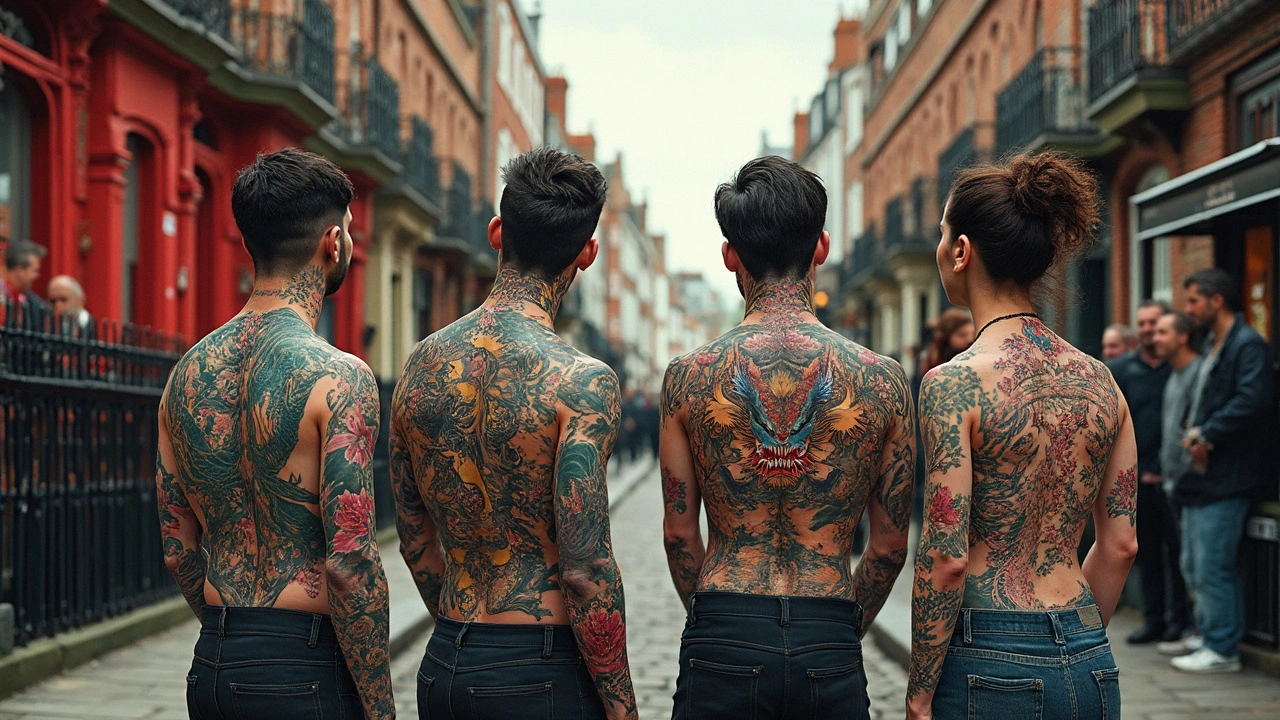
Motifs That Travelled from Prints to Skin
Open up any ukiyo-e book and it's like flipping through a tattoo artist's sketchpad. Loads of the most popular Japanese tattoo designs started out as ukiyo-e motifs. They weren't just picked for looks—each one packs a punch with stories and symbolism.
The Japanese tattoos everyone talks about are loaded with stuff like koi fish, dragons, tigers, cherry blossoms, and fierce warriors. Ukiyo-e prints told the tales of these heroes and creatures way before they hit tattoo shops. Back in the Edo period, people used ukiyo-e to show off popular kabuki actors, mythical beasts, and everyday street life, so the prints were packed with characters and meanings that everyone knew.
Here's a quick look at some classic motifs that made the leap from print to skin:
- Koi Fish: These guys stand for strength and never giving up, thanks to an old legend where a koi swims upstream and turns into a dragon. They’re everywhere in both ukiyo-e and tattoos.
- Dragons: Not the fire-breathing kind from Europe, but more like wise, helpful beings. In ukiyo-e, dragons often bring rain or protection. In tattoos, they mean power and luck.
- Peonies and Cherry Blossoms: Flowers in ukiyo-e aren’t just for show. Peonies mean wealth or bravery, while cherry blossoms hint at how life is beautiful but short. Tattoo artists still love these for big, colorful backgrounds.
- Fudo Myoo: This fierce Buddhist protector shows up in lots of ukiyo-e prints and became a go-to tough-guy tattoo for firefighters in old Japan.
- Warriors (Musha): Especially in the 1800s, ukiyo-e artists like Kuniyoshi made action-packed prints of legendary samurai and rebels. Tattoo fans copied these heroic fighters right onto their arms and backs.
Check out these numbers—tattoo research groups and Japanese art museums estimate that over 70% of classic Irezumi (traditional Japanese tattoo) designs can be traced straight back to ukiyo-e motifs. Here’s a useful breakdown:
| Motif | % in Ukiyo-e Prints | % in Japanese Tattoos |
|---|---|---|
| Koi Fish | 15% | 25% |
| Dragon | 12% | 22% |
| Warrior/Samurai | 18% | 21% |
| Peony/Cherry Blossom | 14% | 20% |
| Fudo Myoo | 5% | 9% |
So, when you're checking out someone’s sleeve covered in koi or a huge back piece of a samurai, just know they're carrying around a piece of ukiyo-e history. Those old woodblock prints didn't just hang on walls—they stuck around, literally, through ink and skin.
How Tattoo Artists Adapt Ukiyo-e Today
Walk into almost any Japanese-style tattoo studio, and you’ll spot elements straight out of ukiyo-e prints. It’s not just about copying old pictures. Artists today tweak these vintage designs to fit modern bodies and personal stories.
First, ukiyo-e was designed for flat paper, but skin has curves, muscles, and constantly changes shape. So, tattoo artists pull apart the original illustrations and rework them to flow over arms, backs, and legs. A koi fish jumping up a waterfall might start with the old composition but will twist to follow the muscles—making the art come alive with every movement.
You’ll also notice they mess with color. Traditional ukiyo-e relied on a handful of dyes, but tattooists now have access to bright pigments that didn’t exist when Kuniyoshi was carving his famous samurai. This means dragons can be more electric, and cherry blossoms can really pop.
Tattooers love to remix the old stories, too. Take Hori Hiro, a well-known Tokyo artist, who updates classic scenes with modern details—like adding cityscapes or replacing vintage kimonos with streetwear. It’s not just about honoring the past; it’s about making the art fit people today.
There’s also more attention to safety and aftercare. The inks are tested for allergens, and artists use hygiene standards that would’ve blown away the original ukiyo-e printmakers. Good artists will always check if a customer understands the meanings behind traditional symbols before the needle even touches skin.
- If you want an ukiyo-e-inspired tattoo, bring in your favorite print, but be ready for the artist to suggest changes so it fits your body’s shape and moves well.
- Classic motifs like tigers, waves, and geishas are always popular, but artists can blend them with modern elements or even personal stories.
- Ask about color choices—today’s inks can match almost any look you want, while still keeping that classic ukiyo-e style intact.
Ukiyo-e lives on because artists keep tweaking it, making sure the tradition grows without losing its roots. If you spot a sleeve with swooping cranes or angry kabuki faces on the street, you’re looking at centuries-old art that’s still evolving, one tattoo at a time.
Tips for Spotting Ukiyo-e in Modern Tattoo Art
Trying to figure out if a tattoo’s roots are in ukiyo-e? There are telltale signs that aren’t too hard to spot once you know what to look for. The smartest move is to focus on the basics: style, subject, and technique. Here’s how you can break it down without needing an art history degree.
Check out these giveaways:
- Bold Outlines: Ukiyo-e prints always used thick, crisp black lines to keep things sharp. That’s a staple in Japanese tattoos too, helping every detail stand out even from a distance.
- Floating Perspective: You’ll often notice scenes and figures that look sort of flat or “stacked.” This isn’t accidental—ukiyo-e artists packed lots of action into one frame, so tattoo artists stick with that stacked style to tell whole stories on your skin.
- Iconic Motifs: If you see detailed koi, fierce tigers, dragons, peonies, or samurai, there’s a high chance those came straight from ukiyo-e prints. Some artists even copy entire poses or clothing patterns seen in famous prints from Hiroshige or Kuniyoshi.
- Color Choices: Look for limited but vibrant colors—think reds, yellows, blues, and black. Early tattoo artists used whatever pigments they could, just like woodblock printers did, so you’ll see those same hues pop out even in modern ink.
- Storytelling: Lots of Japanese tattoos show scenes from folklore or history, just like ukiyo-e prints did. If there’s a story to the body art, you can bet ukiyo-e had a hand in shaping it.
Want to geek out a bit more? Here’s a quick cheat sheet showing common motifs and their ukiyo-e connection:
| Motif | Ukiyo-e Example | Meaning |
|---|---|---|
| Koi Fish | Kuniyoshi's heroic koi prints | Perseverance, courage |
| Dragon | Hokusai and Hiroshige’s mythic scenes | Power, wisdom |
| Peony | Used as backdrop in geisha/samurai portraits | Wealth, honor |
| Wave | The Great Wave off Kanagawa (Hokusai) | Strength, life’s ups and downs |
| Samurai | Kuniyoshi’s warrior prints | Loyalty, bravery |
Here’s a tip: ask the tattoo artist about their influences. If they geek out about Japanese tattoos and start showing off ukiyo-e books or prints in their studio, it’s a good sign you’re seeing the real deal. Old-school artists still reference ukiyo-e compositions to keep that traditional vibe going.
If you want your tattoo to nail the true ukiyo-e look, show your artist a specific print you like. They can pull key details—like the pattern on a kimono or the pose of a character—to make your ink one-of-a-kind but still totally rooted in tradition.

